How was Romania Mare created from three regions ruled by foreigners?
Date: Thu Apr 01 2021 ; Tags:
The territory comprising modern Romania is three ancient regions, Wallachia, Moldova, and Transylvania. Each were ruled by an ever-changing set of ruling families, and often foreign powers were in control. Romanian rulers like Mihai Viteazul (Michael the Brave) sought to unite Romanians into one kingdom, without lasting success. This began to change in 1859 in the wake of sweeping change across Europe. A dream, Romania Mare or Greater Romania, began to be nurtured by leading Romanian politicians. In the 1880's this gelled into the old Kingdom of Romania, and in 1918 the Kingdom grew to contain the largest contiguous territory ever under Romanian rule.
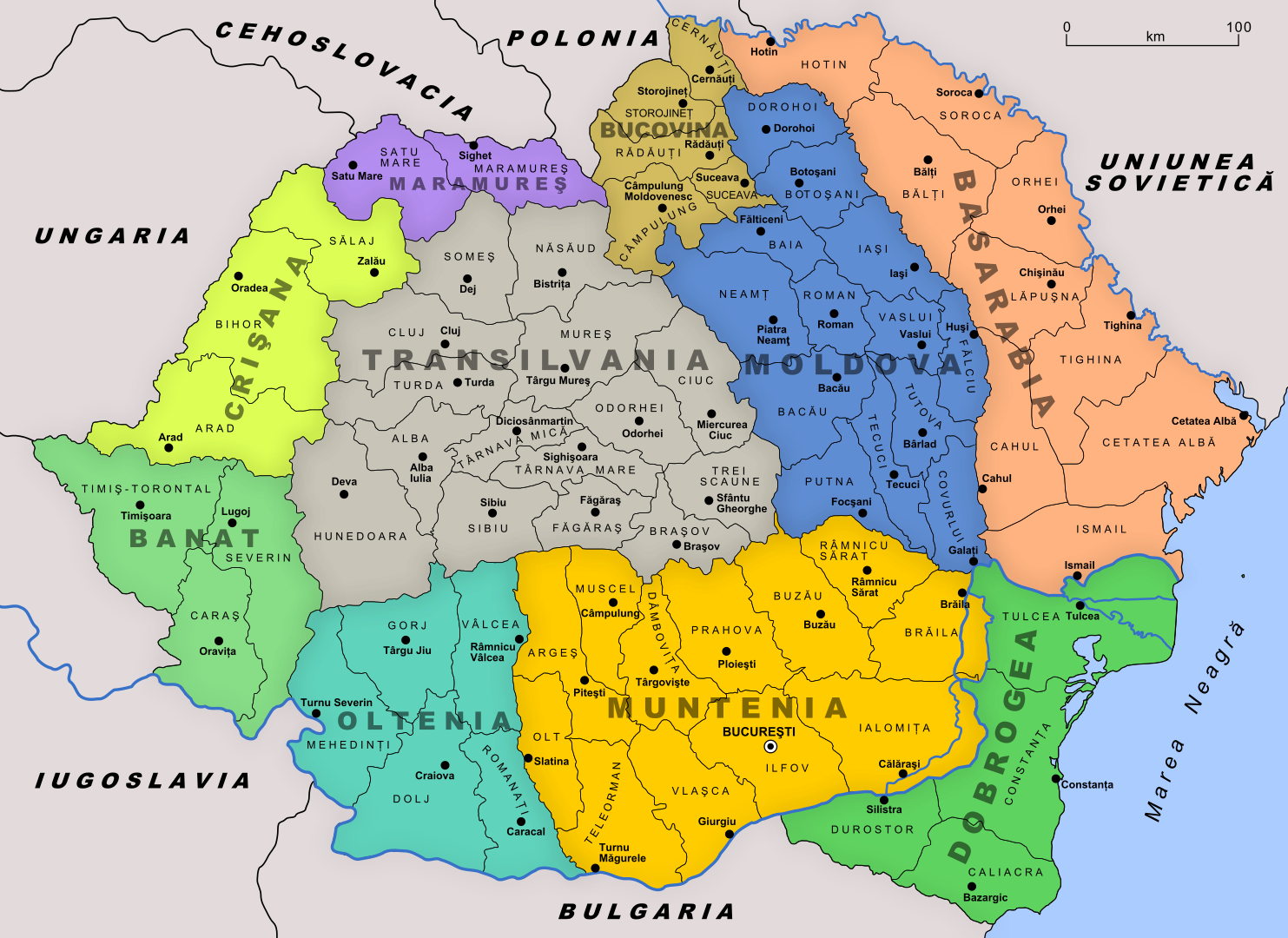
Romania Mare is a phrase that in English we'd call Greater Romania, and is the idea of a nation-state which would incorporate all Romanian speakers. Roughly speaking this means the territory from the Dneister River in the North, to the Danube River in the South, and to some dividing line in the West that would separate Romania from Hungary.
This map shows the borders of Romania from the end of World War I (1918) to the beginning of World War II (1940). During this period, Romania had the largest territory it has ever had, and was the closest to fulfilling the Romania Mare dream described by some Romanian politicians. To the East is the Dneister River and the Black Sea, and to the south is the Danube River, both being natural boundaries. To the west and north the boundary is not set by a natural boundary, but by a zone where the population switched from primarily speaking Romanian to primarily speaking Serbian, Hungarian, or Ukrainian.
This was a single country, under a single political leadership, ruled over by a King and Queen.
For most of known history, the people who spoke Romanian, ethnic Romanians in other words, were split between several principalities, or voivodeships. The title voivode is used across Eastern Europe, and it literally means "leader of warriors" and is roughly equivalent to the title of Duke as used in Western Europe. The Romanian word to describe territory led by a Voivode is Voievodat.
That ethnic Romanian's were split between several territories is not unique in Europe at that time. Most of Europe was ruled this way, with each locality ruled over by whoever won the most recent battle. What was different with Romanians was the frequency with which foreign rulers held sway.
For one brief moment, in 1600, the Romanian people were united in one Prince, Mihai Viteazu (a.k.a. Michael the Brave), united Wallachia, Moldova and Transylvania under his rule. That lasted for less than a year, due to his assassination.
The lasting march toward unification of Romanians began in the mid-1800's, especially with the Revolutions of 1848. In Romania, the revolutions in Moldova and Wallachia sought complete independence from the Turks, and in Transylvania the revolution sought national emancipation from the Hungarians. While these revolutions failed, as did so many of the other revolutions across Europe in 1848, they planted the seed from which lasting change would grow. By 1918, as we'll see below, the Romanian people had managed to join together under one Kingdom.
Before discussing how that happened, we need to briefly consider what makes one an ethnic Romanian. To define the boundaries of a country based on ethnicity is a form of ethnocentric nationalism. If the goal is a unitary country for Romanians, we need to know who Romanians are, and where they live.
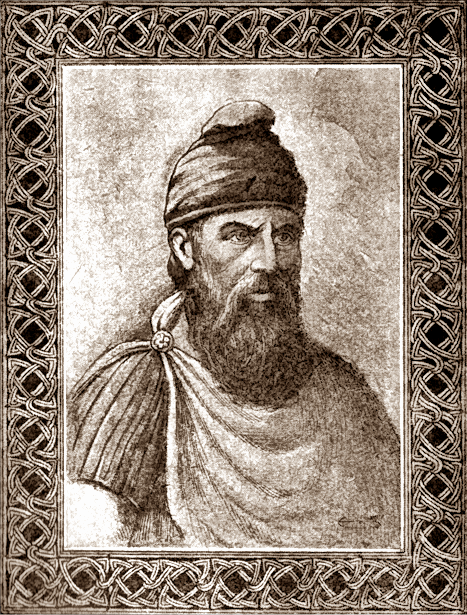
What is the Romanian identity
The historical ancestral people of the territory now known as Romania are the Dacians. The Dacians were an ancient tribe covering roughly the area of modern Romania. Decebal, shown here, was the Dacian King that was defeated by the Roman Empire.
The best origin theory of the Romanian ethnicity is that it's the result of the Roman Empire conquering (a portion of) Dacia in AD 105, after about 20 years of battle. The Romanian language is descended from the Vulgar Latin spoken by the Romans, and influenced by later Slavic and Hungarian invaders. That it's derived from Latin makes Romanian a romance language, but one that is geographically isolated from the other such languages (French, Spanish, Italian, etc).
One core archetype of Romanian culture is the sheep herders who take their flocks high in the Carpathian Mountains during the summer, and down to the flat lands during the winter.
But, this origin theory does not account for the Aromanians, who speak languages very similar to Romanian, and who also have a sheep herding tradition. Small numbers of Aromanians still exist throughout the Balkans, and possibly as far afield as Slovakia. The lack of written records make it difficult to be certain of the origin of both Aromanians and Romanians.
The word Vlach is an exonym referring to ethnic Romanians. This means it is a word other cultures used to refer to Romanians, and is not the word they used themselves. However it is obvious that the region name, Wallachia, is derived from the name Vlach.
The Roman empire pulled out in 275 AD, leaving behind a province named Dacia Aureliana. The territory of Romania became subject to repeated invasions by Bulgars, Pechenegs, Cumans, Huns, and others. The situation which developed over the centuries is that the Huns settled in what's now Hungary, and ruled over Transylvania. Ottomans were a constant threat from the south, and frequently ruled both Wallachia and Moldova. The Russian Empire defeated the Ottoman Empire in 1812, and won control over the territory between the Prut and Dneister Rivers that became known as Bessarabia.
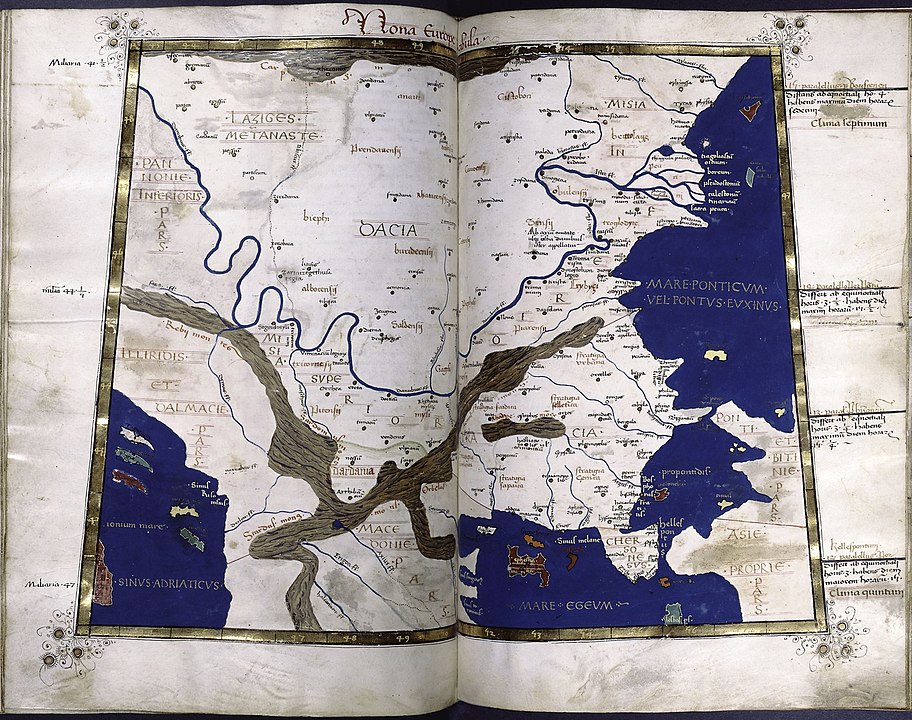
The Ancient territory of the Dacians
The map above is attributed to Ptomely and was drawn after the Dacians were conquered by the Roman Empire. It clearly shows the Black Sea, the Adriatic Sea, and the Agean Sea, as well as the Danube River. While not to any kind of geographically accurate scale, we can easily recognize where the modern states of Turkey, Greece, Bulgaria, and so forth, fit in. The area marked Dacia is north of the Danube River.
The natural boundaries implied by this map are the rivers Tisza, Danube, upper Dniester, and Siret.
Post-WWI Romania Mare versus the Romania Mare dream
The boundaries of Romania between WWI and WWII are sometimes called Romania Mare. Romania had its largest territorial extent during those years, only to lose territory to the USSR following WWII. Romania Mare is also a dream, which is the creation of a nation-state which would incorporate all Romanian speakers.
But, what is the territory which satisfies that goal?
Lucian Boia, a WWI-era politician, described the dream as "De la Nistru pana la Tisa" (From Dniester to Tisza). What this means is an area bounded by the Dneister River in the north - meaning Moldova would be reunited with Bessarabia, bounded by the Danube river on the south, and the Tisza river on the west. This closely matches the territory implied by the Ptomely map.
The first two boundaries, the Dneister and Danube rivers, make sense since ethnic Romanians are the majority population all the way to those rivers. But the Tisza River does not, as we'll see, make sense as an ethnic boundary since the vicinity of that river is occupied by Hungarians.
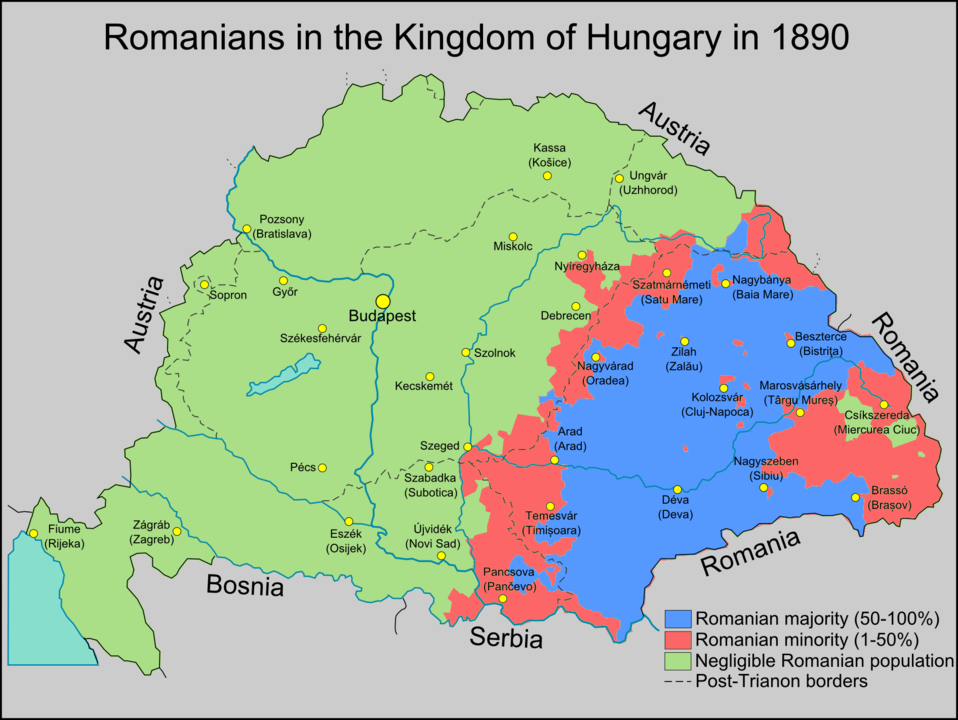
On this map, green marks territory with a Hungarian population, the red is territory where Romanians are a minority, and the blue where Romanians are the majority. The Tisza River is intersects with Szolnok. Clearly, the population of ethnic Romanians did not reach the Tisza River at the time Boia made that statement, nor does it reach that far today.
The current (2021) western boundary of Romania is just west of Timisoara and Arad. That means the post-WWII boundary was drawn to match where the population starts to shift from overwhelmingly ethnic Romanian to ethnic Hungarian.
Also notice the area of Romanian minority near Brasov. That area is the Székely Land, an area inhabited the Székely people, a subgroup of Hungarians. There is a certain amount of political agitation between the Székely population and the Romanian government. As the map makes clear, the majority population in Harghita, Covasna, and parts of Mureș counties is Székely, and some would rather their territory be ruled by Hungary, or that they have some degree of autonomy.
On this map the dashed line shows the post-WWI boundaries of Hungary. Notice that pre-WWI Hungary included what's now Croatia and Slovakia, part of Serbia, part of Austria, as well as Transylvania.
The Union of Moldova and Wallachia in the mid-1800's
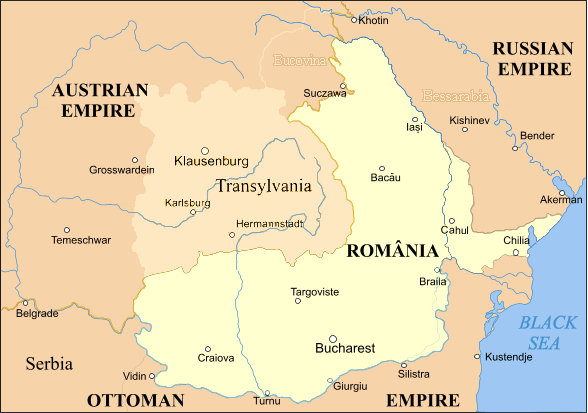
This map shows the Kingdom of Romania that developed after 1859. What happened in 1859 is the formation of the United Principalities of Moldavia and Wallachia. This was formed when Alexandre Ioan Cuza was elected Prince of both the Principality of Moldavia and the Principality of Wallachia.
The Principality of Moldova is the northern part of the territory labeled Romania, and The Principality of Wallachia is the southern part. Moldova traditionally included the territory up to the Dneister river, which is the line stretching from Akerman through Bender to Khotlin. But, by the time the Kingdom of Romania was formed, the Russian Empire had already ruled Bessarabia for 30 years.
The United Principalities became known as the Kingdom of Romania in 1881 following the Romanian War of Independence. That was part of the larger Russo-Turkish War in 1877-78. Initially the Russian Empire suffered heavy losses against the Turks, and turned to Romania for help. Prince Carol I then lead a combined army of Russian and Romanian troops in the Russo-Turkish War, emerging victorious.
Other than adding territory in Dobrogia (a region on the Black Sea coast south of the Danube river), that was the territory of The Kingdom of Romania at the beginning of World War I.
Romania in World War I
The treaties following World War I are what gave Romania its largest territorial expanse. Many refer to the period between WWI and WWII as Romania Mare. But anyone looking at Romania's status in 1917 would think the Kingdom was in dire condition.
Romania at the time was ruled by Kings from the House of Hohenzollern. In 1883, the King of Romania, Carol I of Hohenzollern, signed a treaty with "The Triple Alliance", Germany, Italy and Austria-Hungary. The treaty stipulated Romanias obligation to go to war if Austria-Hungary was attacked.
Therefore, in 1914, at the start of WWI, King Carol I wanted to enter the war as an ally of "The Central Powers", Germany, Austria-Hungary, Ottoman Empire, and Bulgaria. But the population, and the political parties wanted to join with the "Triple Entente", Russian Empire, French Third Republic, and Great Britain.
As a result, Romania stayed neutral until 1916, arguing that because Austria-Hungary started the war that the treaty obligation had not been triggered.
Romania's eventual entry into WWI on the side of the Triple Entente was the subject of negotiation. Romania demanded support for territorial claims, primarily to get Transylvania under its control. Other terms included 300 tons of supplies per day, that Russian troops help with defending against the Bulgarians, that Romanian troops not be subjugated to Russian, that Romania have equal standing at a post-war peace conference, and that France and Britain should launch an offensive against Bulgaria. Most of these terms were not honored.
Upon entering WWI, Romania's first action was to cross the Carpathians for an invasion of Transylvania. Initially that went well, but quickly problems arose not only there, but from Bulgaria. In Transylvania the German and Austrian-Hungarian forces sent in eight divisions for a counter-offensive. From Bulgaria came a multi-national comprised of Bulgarian, Ottoman, and German divisions. They started by invading Dobrogia, then crossed the Danube eventually to take all of Wallachia.
By December 1916, Bucharest had fallen, and Wallachia, Dobrogia, and part of southern Moldova, were under control of the Central Powers. The Romanian government set up operation in Iasi, and the Kingdom of Romania was essentially limited to portions of Moldova. If it were not for the support of the Russian Empire, Romania would have ceased to exist.
In mid-1917 a series of battles, Mărăști, Mărășești and Oituz, created a turning point for the Eastern Front of WWI. Romanian forces had a lot of success against German and Austro-Hungarian forces, inflicting great losses on those armies. But, by November 1917 the October Revolution in Russia, and the subsequent Russian Civil War, meant that the Russian Empire was unable to continue helping Romania.
During 1917-18, one task of the government-in-exile in Iasi was to achieve unity among Romanians. This wasn't about building an armaments industry, building guns, organizing an army, and so on (these things did happen), but was more political. The goal was building a national consensus for a successful liberation war. This included structural transformation such as reforms in response to demands from the population.
The Russian Civil War gave Bessarabia the opportunity to declare independence. It started by creating its own parliament, the Sfatul Țării, and to declare the Moldavian Democratic Republic. During the Winter of 1918, Romanian troops crossed the Prut river aiming to push away the presence of Soviet troops. By April 1918, this was successful, and with Romanian troops in control of Bessarabia, the Sfatul declared unification with the Kingdom of Romania.
By May 1918, Romania signed a treaty with the Central Powers that imposed harsh conditions. However, it recognized the union of Bessarabia with the Kingdom of Romania.
The 1918 Treaty of Bucharest required that Romania give Dobrogia back to Bulgaria, give other territory to Austria-Hungary, disbanding some of the army, Romanian oil fields were to resume supplying oil to Germany, occupation costs to be paid by Romania, excess agricultural production given to the Central Powers, and more.
However, King Ferdinand of Romania, the successor to Carol I, never got around to signing this treaty.
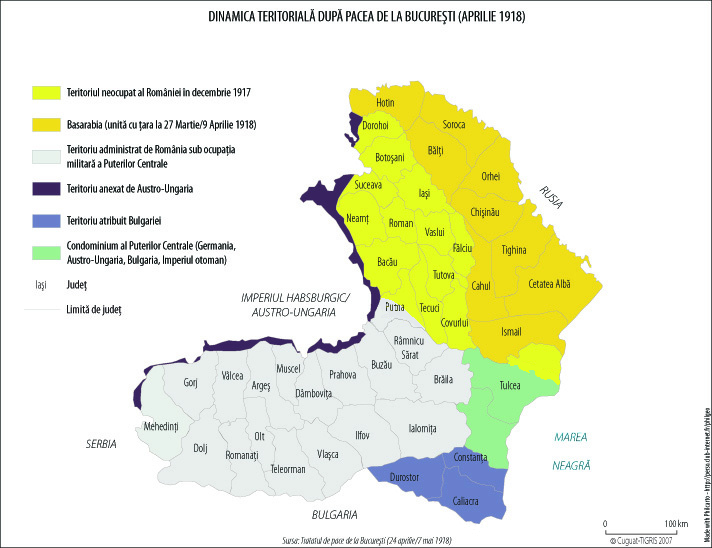
After signing the 1918 Treaty of Bucharest, the boundaries of the Kingdom of Romania expanded to the Dneister, but they lost Dobrogia, and in general the Romania Mare dream must have seemed impossible.
The purple area was annexed by Hungary. The darker yellow, Bessarabia, was gained from Russia. The green and blue areas were handed back to Bulgaria.
The bottom line is that while the 1916 Treaty of Bucharest promised that Romania would have territory matching the Romania Mare dream, its disastrous entry into WWI meant that they were in a bad place. The Kingdom of Romania was nearly destroyed, and they made the best deal possible.
What changed everything is the outcome of the Treaty of Versailles, and the later Treaty of Trianon.
The transition to Romania Mare
In May 1918, The Kingdom of Romania made the best deal it could given the bad circumstance it was in. So, how was it they were able to transition in just a couple years to a much larger country?
The key was the collapse of the German and Austro-Hungarian forces. There was several facets to that collapse.
- The Vardar Offensive in the Balkans knocked Bulgaria out of WWI in the autumn of 1918. That gave Romania more freedom of action, and they declared war again on November 10, 1918, only one day before the war ended in Western Europe with the Armistice.
- In 1918, Austria-Hungary collapsed after defeat on the Italian Front.
- By the end of October 1918, a dissident in Hungarian politics staged the Aster Revolution, taking over control of the Hungarian Government. The new leader, Mihály Károlyi, ordered the unilateral disarmament of the Hungarian Army, which started on November 2, 1918.
- Then on November 5, the Serbian and French armies crossed the southern border of Hungary.
- Then on November 8, the Czecholovakian Army crossed the northern border of Hungary.
- Then on November 13, the Romanian Army crossed the eastern border of Hungary.
Since there was a lot of moving parts going on at once, try this map:
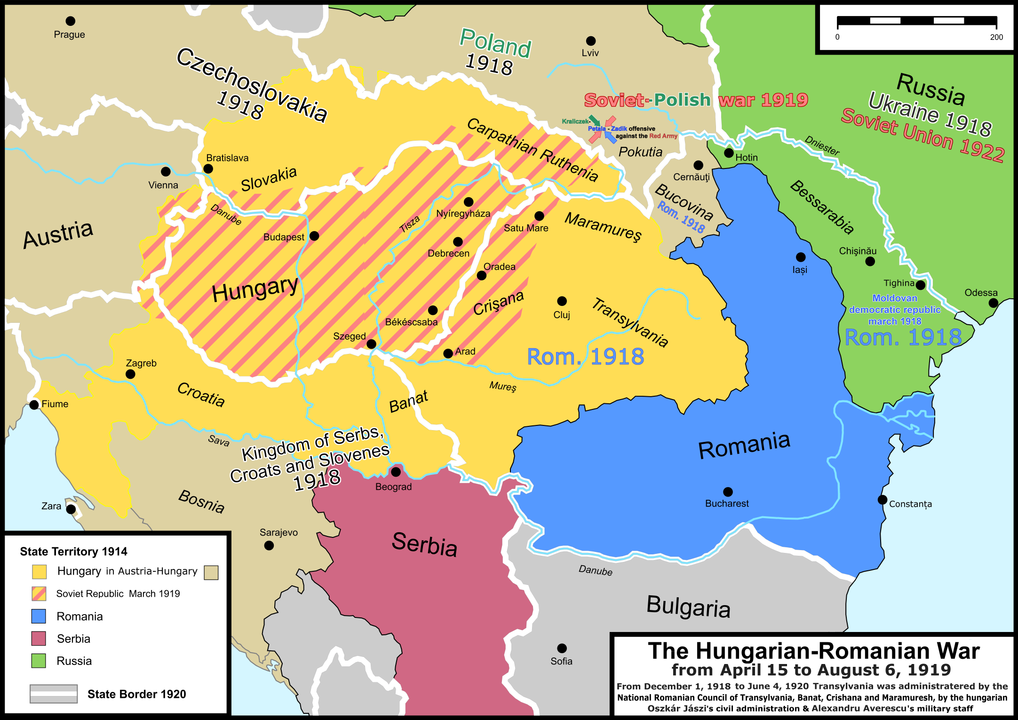
Remember that the yellow area is the former boundary of Hungary. Croatia split off to form a Kingdom with Slovenia and Serbia. Czechoslovakia took control of some land that today (in 2021) is part of Ukraine, and Romania invaded Transylvania. At the same time the Soviet Union and Poland had a war. In other words, a lot was going on.
Romania's army was not in good condition following WWI, and much of the active army was busy holding Bessarabia against any possible Soviet effort to retake that territory. The invasion of Transylvania was with whatever remaining army units could be put to the task.
Transylvania was not the only territory Romania had its eye on. Bukovina is a small region north of Moldova. Between early October 1918, and the end of November 1918, Bukovina political leadership of both Ukrainian and Romanian ethnicity agitated for liberation from Hungary. On November 4, Ukrainians took control Czernowitz (now known as Chernivsti), the largest city in Bukovina. But, remember that Romania did not declare war again until November 10. By November 12 Czernowitz was siezed by the Romanian Army, and the Romanian National Council was established. On November 28, the Romanian National Council convened the General Congress of Bukovina, which formally issued a requested the union of Bukovina with The Kingdom of Romania. On December 19, the Romanian government formally issued a decree annexing Bukovina.
The Ukrainian deputies (38% of the population) and Jewish deputies did not attend that General Congress.
On December 1, 1918, the Union of Transylvania with Romania was declared in Alba Iulia. In practical terms, the effort to bring Transylvania under Romanian governance was still being fought, for example the army entered Kolozsvár (Cluj) on December 24. Still, an assembly of 1,228 elected representatives of Romanians in Transylvania, Banat, Crișana and Maramureș convened at Alba Iulia and unanimously decreed:
The unification of those Romanians and of all the territories inhabited by them with Romania.
Also on December 24, after various political negotiations and, King Ferdinand signed a decree sanctioning the Union of Bessarabia, of Bukovina, and of Transylvania with Romania. The Hungarian government protested.
By February 28, 1919, the Paris Peace Conference was underway. On that day, the Allies meeting at that conference declared a new demarcation line to which the Romanian Army would advance. That line covered railway lines connecting Szatmárnémeti (Satu Mare), Nagyvárad (Oradea), and Arad, but the Romanian Army was prohibited from entering those cities.
On March 21, 1919, there was a coup against the Mihály Károlyi government. The new government, led by Béla Kun, was quickly declared as the Hungarian Soviet Republic, ruled under communist ideology.
That put Romania between two Communist countries, Soviet Russia and the Hungary Soviet Republic. At the Paris Peace Conference, Romania asked for permission to send troops into Hungary to depose the Bela Kun's government. The Allies were reluctant to allow that to occur however, and sought to instead negotiate a solution rather than fight.
However, when the Romanian Army advanced to the declared demarcation line, it did not stop there. Instead it kept advancing looking to reach the Tisza River.
Hungary was in the position of fighting with Czechoslovakia and Romania at the same time. They settled an Armistice with Czechoslovakia first, withdrawing from the land they'd invaded, and turned to fighting off the Romanian Army. During July 1919, the Hungarian and Romanian armies fought several times across the Tisza River. At the end of July, Romania crossed the river, and chased the Hungarian Army into Budapest. In early August 1919, the Hungarian Soviet Republic was disbanded.
The Romanian army did not stay in Hungary for the long term. Eventually, the powers that existed at the time settled the boundaries of Hungary and Romania at the white line shown above.
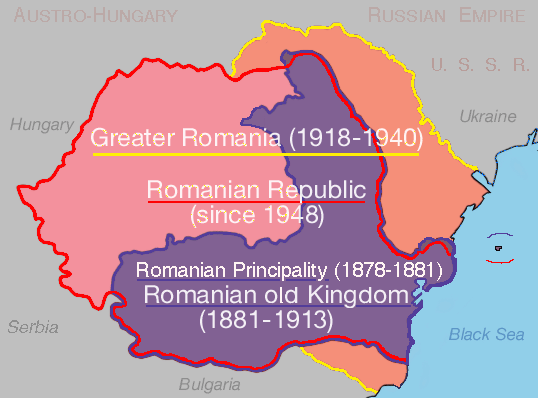
That was a lot of details, but this map should help to understand the situation.
The outer extent, the yellow line, is the formalized boundaries after everything was said and done at the Paris Peace Conference, and the Treaty of Trianon was signed. The events we just discussed involve various military and political actions on different territories, but which do not constitute a final resolution.
In any case, this map demonstrates the territorial transition from the Old Kingdom to the post-WWI Greater Romania. It also shows, inside the red line, the post-WWII modern Romanian territory.
Territorial decisions at the Paris Peace Conference, and the Treaty of Trianon
As important as were the actions on the ground just described, meetings at the Paris Peace Conference was where the real decisions were made. We alluded to this earlier with the Romanians ordered to obey a line of demarcation, which they ignored.
The Peace Conference primarily involved the United States of America, Great Britain, France, and Italy, as the victorious allied powers. The conference resulted in several peace treaties, that redrew national boundaries all around the world, and imposed heavy sanctions on the belligerent nations. Another major decision was the establishment of The League of Nations.
Of the treaties coming from the Peace Conference, the Treaty of Trianon (named after the palace where it was signed) covered the overall settlement with the Kingdom of Hungary. The status of Hungary's borders was settled through this treaty, which greatly affected the status of Romania's borders.
Romania's representative at the conference, Prime Minister Bratianu, was primarily interested in securing Transylvania and Bukovina for Romania. It was Bratianu who ordered Romania's troops into Hungary, against the objection of the Great Powers.
A recent pseudo-historical documentary, Queen Marie, covered this time period from the point of view of Queen Marie of Romania. It showed Bratianu standing in front of the table at which The Great Powers were seated, angrily shouting at them about Romania's boundaries. The film did not explain the invasion of Hungary, just that Bratianu was not having success with negotiating Romania's desired boundaries. Instead the film claimed that the Great Powers attempted to hold Romania to the terms of the 1918 Treaty of Bucharest, which left Transylvania in the hands of Hungary.
The film then showed Queen Marie taking a trip to Paris to assist Bratianu. It claimed that the key was when Marie arranged a private dinner meeting with Pres. Wilson (USA) and his wife, in which she argued that a strong Romania would be better for the balance of power in Europe. However, the film did not show that a resolution occurred during the time period she was in Paris, and she returned to Bucharest seemingly having failed. It wasn't until some time later that the issues were resolved, in Romania's favor.
In reality, we see from the events described earlier that Romania made several moves to bring the desired territories under its control. It invaded Bessarabia, Bukovina, Transylvania, and The Banat, in order to establish a military presence, and to get political alignment between The Kingdom of Romania and the populations in each area. Largely it seems the populations, especially in Bessarabia and Transylvania, gladly accepted rule by Romania. Bukovina was a different story, where the large Ukrainian minority objected to Romanian rule.
It seems the Peace Conference participants must have recognized two things. First, the declarations from the various territories desiring union with Romania, and second the distribution of ethnicities.
The Treaty of Trianon was signed on June 4, 1920. For Romania, it ratified massive territorial and population gains. For Hungary, it ratified a great decrease in its territory and population. Largely speaking the new national boundaries were established along ethnic lines. One result was significant populations of ethnic Hungarians now located in Romania and Slovakia.
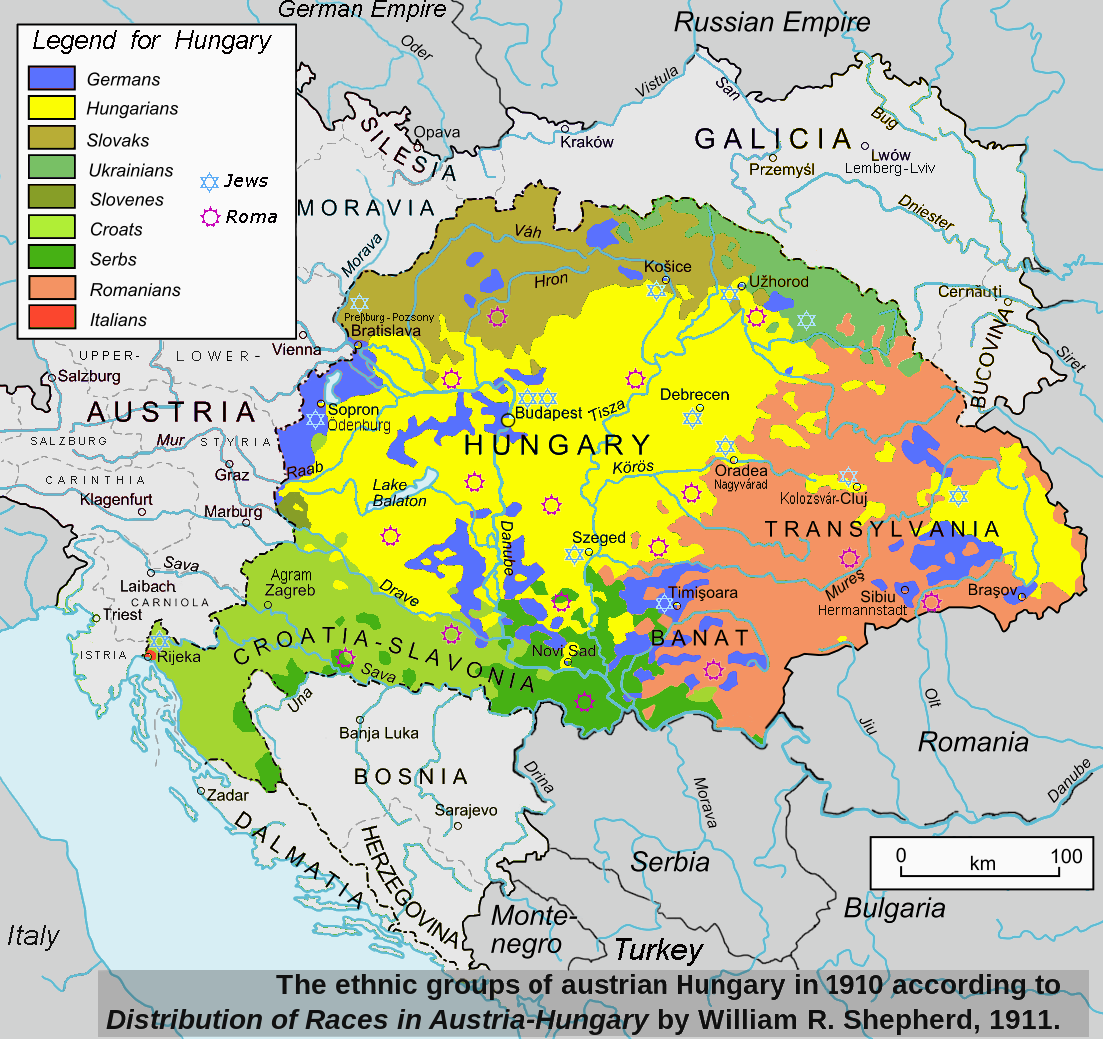
This is another map of the ethnicities, this time covering Hungary, Austria, Slovakia, Transylvania/Romania, Serbia, and Croatia. It clearly shows that largely the new territorial lines were drawn on ethnic boundaries. But it also shows that the ethnic mix in Europe is not clean enough to draw a clear boundary that satisfies everyone.
Consider the number of German areas shown on this map. The presence of ethnic Germans in Sibiu (a.k.a. Hermannstadt) in Transylvania dates to the 1200's, and is the result of Saxon trading barons sending a delegation to set up a post in that area.
Look to the north, and you see an area of green that is occupied by Ukrainians. This is the plains to the south of the Ukrainian section of the Carpathian mountains, and today (2021) that territory is part of Ukraine. But notice that region contains areas with Romanians, indicating there is no sharply defined boundary with clean ethnic distribution.
Then look at the Tisza River, and remember that Romanians dreaming of Romania Mare wanted their territory to extend to that river. But if the goal was an ethnically pure state, why extend their boundary deep into an area occupied primarily by Hungarians?
Also look around the map and see the number of markers for Roma and Jews. The Jews are what everyone knows, people of the Jewish religion/culture, who settled all across Europe. Roma in this case is not a variation of Romanian, but refers to Gypsey's. And this is not about the friendly wandering fortune tellers you see in movies. Real Gypsey's are descendants of a tribe that left a region of India over 1000 years ago, and their migrations brought them to Europe. Neither of these groups ever formed a large enough population concentration to be able to coalesce into a region of their own. During World War II, both cultural groups were the target of the Holocaust -- the Holocaust was not limited to Jews, but also included Gypseys and others.
In other words, the history of Europe is full of invasions and counter invasions and rulers taking each others territories. An example of this is that the whole presence of Magyar's (Hungary) in this area is the result of such an invasion in the late 800's AD.
Great Romania, a.k.a. Romania Mare, between 1920-1940
Here is another breakdown of the territory of Romania following the Treaty of Trianon:
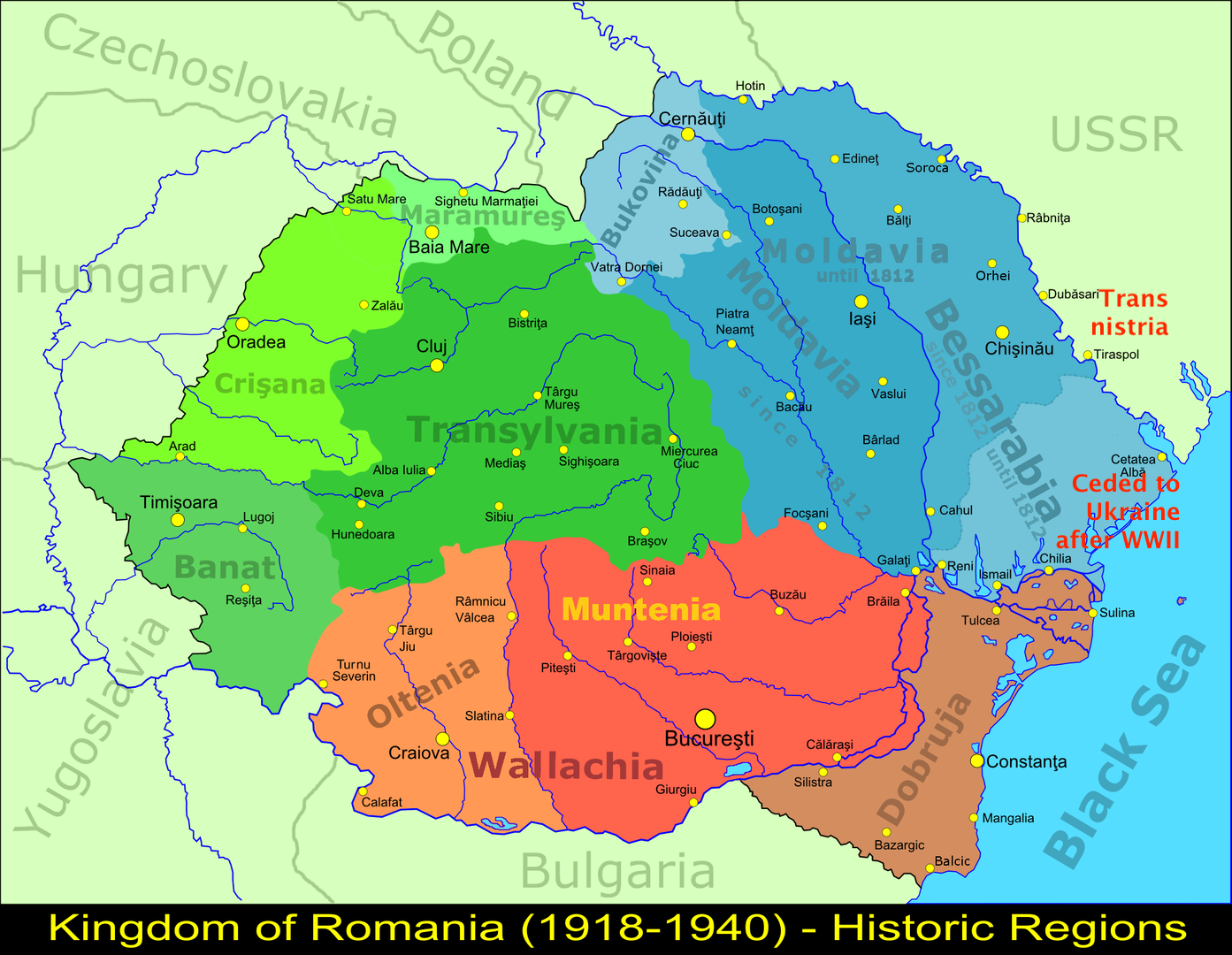
The western boundary is roughly the line of demarcation demanded by the Paris Peace Conference. This roughly corresponds to the ethnic distribution shown in maps above. Namely, this is where the local population switched from primarily Hungarian to primarily Romanian.
The Banat was split between Romania and the territory that is today (2021) Serbia. While the Serbian part of The Banat is largely populated by Serbians, there is even in 2021 a significant population of Romanian speaking people. And, for that matter, the same holds true in northern Bulgaria.
Up in Bukovina, recall that the Ukrainian population objected to how the Romanians took control of that region. Today (2021) the northern part of Bukovina is part of Ukraine.
During WWII, The USSR annexed Bessarabia, and maintained control over it after WWII. Today (2021) that territory is The Republic of Moldova, except for the southern-most section which is part of Ukraine.
The southern-most part of Dobrujia (Dobrogia) was, likewise, returned to Bulgaria after WWII.

This is yet another rendition of Greater Romania between 1920 and 1940. This map was included due to an additional territory that, during that time period, was part of the USSR, but is today (2021) part of of The Republic of Moldova.
Moldavian ASSR (Autonomous Soviet Socialistic Republic) was a territory created by the USSR in 1924. There was a significant enough population of ethnic Romanians (remember, that ethnic distributions in Europe are not cleanly divided) that the USSR decided they could be given their own government. However, reports are that the USSR did not do this out of altruism, but from a longer range goal of creating leverage with which to spread Communism further into Europe.
Romanian territory during WWII
We've already suggested that Romania's territory, Romania Mare, did not remain as shown here after WWII.
In fact, one of the first moves of WWII was the USSR's annexation of Bessarabia. This occurred in June 1940, which of course was well after the German invasion of Poland, Austria and Czechoslovakia.
In August 1939, Nazi Germany and the USSR signed the Molotov-Ribbentrop Pact. This was a secret agreement in which the USSR and Germany partitioned Poland, Lithuania, Latvia and Estonia between themselves. Further, it declared that Germany was disinterested in any claim the USSR had for Bessarabia.
Within a few days of the signing of the pact, Germany invaded Poland. Later, one day after the USSR signed a cease-fire with Japan, the USSR invaded Poland. Over the next year, the USSR invaded and annexed Lithuania, Latvia, Estonia, and part of Finland. And, on June 26, 1940, the USSR sent an ultimatum to the Kingdom of Romania to hand over Bessarabia.
Reportedly the USSR had planned a full invasion. Instead, the Romanian government agreed to simply pull out of Bessarabia, and to avoid conflict. Perhaps a contributing factor is that just 4 days earlier, on June 22, France (a guarantor of Romanian borders) fell to Nazi Germany.
By August 2, 1940, these changes were instituted due to USSR actions:
- The Moldavian Soviet Socialist Republic was declared as a Republic of the Soviet Union.
- Parts of the Moldavian Autonomous Soviet Socialist Republic were added to Moldavian SSR
- The northern parts of Bukovina and Moldova, with primarily Ukrainian ethnicity, were added to Ukraine SSR
- The southern part of Moldova, again primarily Ukrainian ethnicity, was added to Ukraine SSR
But, wait, that's not all. In quick succession, the northern part of Transylvania was given to Hungary.
Clearly from the Hungarian perspective, its drastic change of status in the world after World War I would be unpopular. They'd gone from being a fairly large and powerful Kingdom, to a relatively small state, and large populations of ethnic Hungarians trapped within both Czechoslovakia and Romania. Most of the rest of the world would say "we don't care" because of the great deal of pain and suffering that resulted from World War I, which was started by Austria-Hungary. In any case, that national trauma led Hungary to become closely allied with Benito Mussolini's Italy and Adolf Hitler's Germany.
There were two territory changes which benefited Hungary. In the First Vienna Award of 1938, Hungary was awarded parts of southern Czechoslovakia. Then in 1939, Hungary was able to annex Subcarpathia and Carpathian Ruthenia, the territory to the south of the Carpathian Mountains. This award did not affect Romania, since those territories were part of Czechoslovakia.
Shortly after the USSR's annexation of Moldova, Romania repudiated the Anglo-French guarantee of 13 April 1939. It had become worthless because France had been subjugated to Nazi Germany. The next day, King Carol II sent a letter to Hitler making suggestions, which seemingly came across as desperation by Romania. Germany, for its part, sought to revise the territorial awards from the Treaty of Trianon in favor of Germany's old allies, Hungary and Bulgaria.
As a result, Hungary and Romania entered into negotiations which broke off unsuccessfully. The German and Italian governments proposed an arbitration process, which the Romanian Crown Council saw as an ultimatum. That led to another round of negotiation, this time including the foreign ministers of Germany and Italy. That led to an agreement in which Hungary was awarded 43,492 square kilometres (16,792 sq mi), with a population of 2,667,007.
That agreement became the Second Vienna Award, of August 1940.
Then, on September 7, under The Treaty of Craiova, the southern portion of Dobrogia, known as the Cadrilater, was ceded to Bulgaria.
These maps show the territorial changes to Romania in the late summer of 1940.
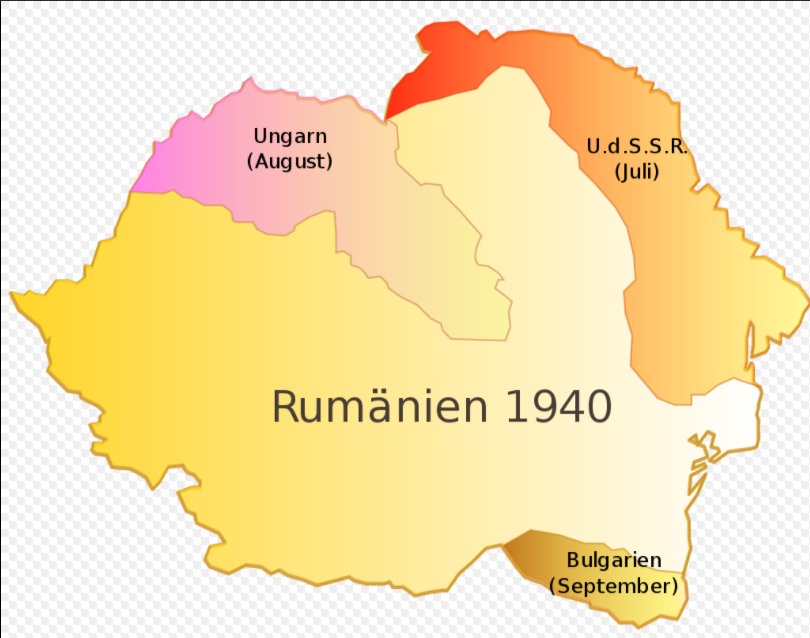
|
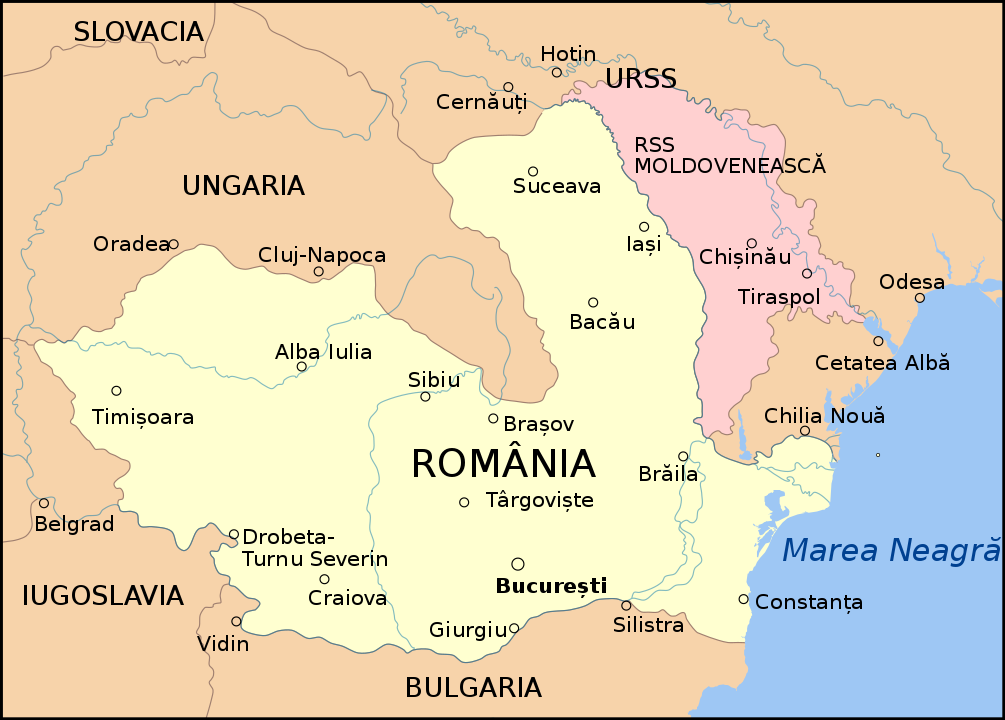
|
Romanian reaction to losing territory in 1940
Of course Romanians were upset at losing so much territory.
On September 5, King Carol II proposed that General Ion Antonescu, the chief of the Army, form a new government. Antonescu forced King Carol II to abdicate and to flee Romania. Antonescu formed an alliance with remnants of the Iron Guard, an anti-Semitic Fascist political party. Michael, son of King Carol II, succeeded his father as King. The first act of King Mihai (Michael) was to grant General Ion Antonescu unlimited power as Conducător (leader) of Romania, and to relegate himself a largely ceremonial role.
On September 14, Romania was declared a National Legionary State, because the Iron Guard (a Romanian ultranationalist, antisemitic, anti-Hungarian, antiziganist, anti-communist, anti-capitalist and pro-Eastern Orthodox part) had achieved dominance in the Parliament. The word Legion in that title is because the Iron Guard was also known as Legion of the Archangel Michael (Legiunea Arhanghelului Mihail) or the Legionnaire Movement (Mișcarea Legionară). Hence, this meant the Iron Guard was in charge of the government, and quickly it became the only legal political party.
Starting in October 1940, German troops began entering Romania, not as an invasion force, but by invitation. In November 1940, Romania formally joined the Axis powers.
On November 27, 1940, 64 former dignitaries of the Romanian government were executed by the Iron Guard at the Jilava prison while awaiting trial, in what is known as the Jilava Massacre. Later that day, historian and former prime minister Nicolae Iorga and economist Virgil Madgearu, a former government minister, were assassinated.
On January 20, 1941, the Iron Guard attempted a coup to fully take over the government, as well as a pogrom of Jews in Bucharest. Within four days, Antonescu put down the coup, and forced the Iron Guard out of the government. Iron Guard members who are part of the government took refuge in Germany. The National Legionary State was abolished, and instead Antonescu declared Romania a "National and Social State." On 14 February 1941, the National Legionary State was formally abolished.
The consensus opinion is that Romania joined the Axis Powers because Romania wanted to regain Bassarabia from the USSR. But that's only part of the story. It's also true that, at that critical time, the Romanian Government was under the influence of an ultra-fascist movement, the Iron Guard.
Romania and Germany attack the USSR - The Eastern Front
On June 22, 1941, German troops supported by Romanian troops attacked the Soviet Union. They conquered Bessarabia, Odessa, and Sevastopol, then kept going eastward toward Stalingrad.
Germany rewarded Romanian help by awarding them Bessarabia and Northern Bukovina, in other words returning the territory annexed by the USSR. As a substitute for losing northern Transylvania to Hungary, Romania was also allowed to administer the land between the Dneister and Bug rivers, which included the area known today (2021) as Transnistria, as well as the cities of Odessa and Nikolaev.
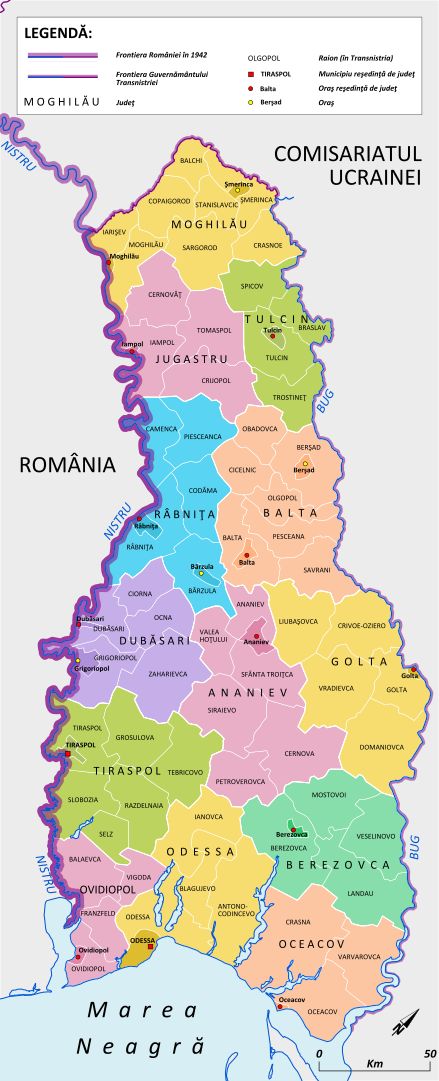
Antonescu's government used this territory, The Transnistria Governorate, to conduct a holocaust of both Romani (Gypsey's) and Jewish people, who were deported from Bessarabia and Bukovina to Transnistria. It was never incorporated as Romanian territory, and therefore the government felt freedom to use it as a killing field. The Romani and Jews living in other parts of Romania were not deported to Transnistria, and therefore most of them survived WWII.
Of course the USSR invasion became a disaster known as the Battle of Stalingrad. The invaders, including Romania, had significant losses at that battle.
Romania supplied oil and other supplies to Germany, sustained Allied bombing campaign
During WWII, as during WWI, Romania's oil fields were very important to the German Armies. The oil fields around Ploiesti are one of the few oil rich areas in Europe.
Germany took all the oil it could, as well as food and other supplies, without making payment to Romania. This, as well as the overall war costs, caused massive inflation in Romania.
Romania flips sides from Axis powers to Allied powers
Following the disastrous Battle of Stalingrad, German (and Romanian) forces were unable to maintain the Eastern Front. Losing WWII in the East was a foregone conclusion for the German forces.
USSR forces retook The Transnistria Governorate in March and April 1944. It was clear that USSR forces would shortly try to enter Bessarabia and Romania. That led to Romania switching sides.
A very important event in WWII's Eastern Front came when King Michael (King Mihai) of Romania staged a coup, and arrested Antonescu. Romania immediately offered an armistice with Russia, kicked German forces out of Romanian territory, and kept fighting alongside Soviet troops. It's estimated this shortened WWII by six months since it hastened the surrender of Hungary, and the collapse of Nazi Germany.
Preplanning began in mid-June 1944. Representatives of King Mihai met with Communist Party conspirators. They devised a plan under which the King, as commander-in-chief, would order the Romanian Army to turn their weapons against Nazi Germany troops. At the same time the King would meet with Antonescu to demand his signature on an Armistice with the Allied forces, and if Antonescu were to refuse then he would be arrested on the spot.
That plan unfolded on August 23, 1944. Initially King Mihai offered the German armies safe departure from Romanian territory. But the German armies would have none of that, and instead fought to retake Romania.
That pitted the Romanian armies against German, with whom they'd just the day before been in an alliance. Soviet troops were able to accelerate their invasion of Romania, and together they kicked Germany out of Romanian territory. Soviet troops also took over 100,000 Romanian POW's, many of whom were sent into the Soviet Union where they perished in prisoner camps.
Together the Romanian and Russian armies invaded Transylvania in the process of expelling the Germans from Romania. Remember that Hungary was in control of part of Transylvania, and was very much on the side of the Germans. The Hungarian and German armies fought together, and during September 1944 there was a bloody battle, The Battle of Turda.
The Romanian Army continued fighting alongside the Soviet Army, including the Prague Offensive in May 1945.
The status of Post-WWII Romania
In the 1947 Treaty of Paris, Romania was not labeled as a co-belligerent nation. Instead, they were labeled an "ally of Hiterlite Germany", largely because Romania switched sides and acted in the interest of all United Nations.
One result was a few border changes to Romania, again:
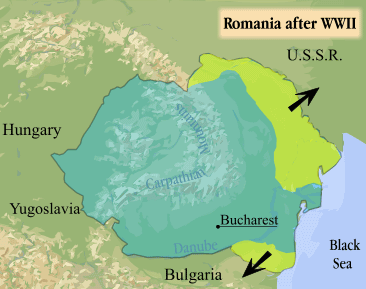
The changes were:
- The portion of Transylvania that Germany awarded to Hungary in the Second Vienna Award, of August 1940, was given back to Romania.
- North Bukovina went to Ukraine SSR
- The southern part of Bessarabia also went to Ukraine SSR
- The central part of Bessarabia became Moldova SSR
- The Transnistria Governorate was dissolved, but a portion was tacked onto Moldova SSR and is today (2021) known as Transnistria
- The southern part of Dobrogia went to Bulgaria
Another change was political. Prior to the end of WWII, Winston Churchill (Prime Minister of Great Britain) and Joseph Stalin (Head guy in USSR) made an agreement over the sphere of influence the USSR would have over Eastern Europe. They agreed that Romania would be highly controlled by the USSR.
Because of Romania's status, it (like Finland) had to pay war reparations to the USSR. Further, the USSR occupied Romania for many years, from August 1944 to August 1958. Reports from not only Romania, but Hungary, are that the Soviet Occupation was like a reign of terror in which Soviet troops engaged in a wide range of crimes including petty theft, big scale theft, destruction of property, kidnapping, and murders.
In part the purpose of the Soviet Occupation was to enable free movement of Soviet Troops within Eastern Europe in order to quell the belligerent states of World War II. To put it another way, the Soviet Army was tasked with occupying part of Austria. Therefore a line of communication and supply was required through Romanian territory to support those troops.
This changed in 1955 when the Austrian State Treaty was signed, which re-established Austria as a sovereign state.
Despite having been lauded as a hero, King Michael was forced to abdicate on December 30, 1947, and forced to leave Romania. He was not able to return until long after the Romanian Revolution of 1989.
Romania was never a Soviet Socialist Republic, unlike most of its neighboring states.
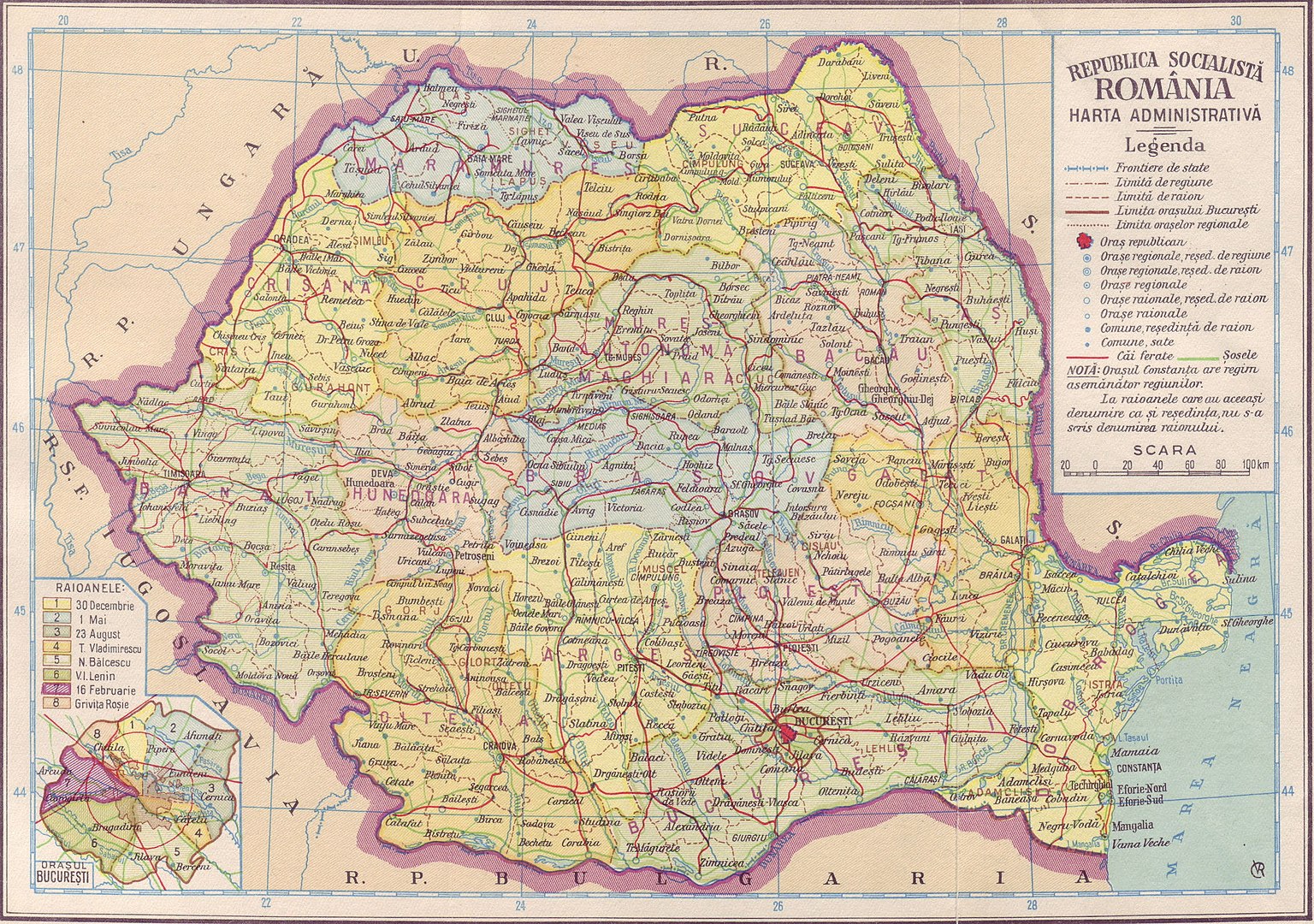
|
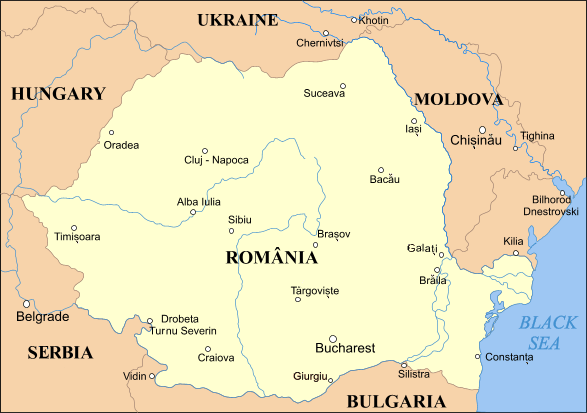
|
The resulting boundaries of Romania were very similar to the boundaries at the end of WWI, but with the changes outlined above.
On the second map, pay attention to the boundaries of Moldova. The Republic of Moldova is the successor state to Moldova SSR. Its boundaries do not reach the Black Sea, because the coastal counties were made part of Ukraine. Also notice the territory across the Dneister River, which is the area known now as Transnistria.
Political result of modern Romania not fully implementing Romania Mare
The original dream for Romania Mare was integrating all territories with Romanian speakers into one country. On this page we've followed that project from the mid-1800's up through the establishment of the current (2021) boundaries following World War II.
It's clear from the evidence on this page that it's difficult to draw a boundary around territory which only contains Romanians. Because of the history of this territory, there are pockets of non-Romanian speakers all around Romania. Further, there are pockets of Romanian speakers who live in neighboring countries.
For example, the western boundary of Romania was drawn in the middle of an area where the 1890 census showed Romanian speakers were in the minority. That boundary ensured that some Romanian speakers were located to the west of that boundary, in what is now Hungary. Likewise, there are significant populations of ethnic Germans and ethnic Hungarians within today's Romanian territory, largely because events which happened hundreds of years ago landed the ancestors of those people in what is now Romania.
In the 2020 elections in Romania, a brand new party (Alliance for the Unity of Romanians, or AUR) made a big splash in Romanian politics. During those elections, the AUR won control of a handful of cities, but more importantly became the 4th largest party in the Romanian Parliament, pushing out a couple long-standing parties.
AUR becomes important here because part of its ideology is very similar to the Romania Mare dream. Namely, AUR advocates for the unification of all Romanians "wherever they are located, in Bucharest, Iași, Timișoara, Cernăuți, Timoc, Italy, or Spain." Cernăuți is the Romanian name for the capital of northern Bukovina, currently called Chernivtsi, which was part of Romania between 1918-1940, and was added to Ukraine by the USSR following WWII. Timoc refers to a region split across eastern Serbia and northern Bulgaria, just across the Danube River from Oltenia (a region of Romania), where there is a large population of Romanian speakers.
The AUR explicitly wants to reunite Moldova with Romania. But it is clearly advocating for going beyond that, to integrate further territories currently within Ukraine, Serbia, and possibly Hungary.
Some describe AUR as having open sympathy for the Legionnaires (the Iron Guard). Some of its founding members are openly approving of Iron Guard ideology. Just like the Iron Guard, the AUR ideology includes religious nationalism connected to the Eastern Orthodox Church.
The success of AUR suggests there is a thread of Romanian society that wants the full territorial expansion of the Romania Mare dream. A big gaping wound in Romania's side is that The Republic of Moldova is a separate country, and even today it is subject to strong Russian influence. At the same time there are strong prohibitions in Europe against changing boundaries, because of the risk of war. Even an attempt to unite the Republic of Moldova with Romania, while it would be very positive for Romanians, runs the risk of war with Russia.
Links
- History of Romania (Wikipedia)
- Dacia (Wikipedia)
- Origin of the Romanians (Wikipedia)
- Territorial evolution of Romania (Wikipedia) - Discusses the evolution of Romania from the 14th Century to modern times
- Greater Romania (Wikipedia) - Discusses the development of the concept of Romania Mare
- Laying the groundwork for Modern Romania
- United Principalities of Moldavia and Wallachia (Wikipedia) - The first step to establishing Romania as a Nation was for Moldova and Wallachia to come under the leadership of one political figure, Alexandru Ioan Cuza
- Romanian War of Independence (Wikipedia) - In 1877-78, the Russo-Turkish War also served to give Romania independence from the Ottomans
- Kingdom of Romania (Wikipedia) - Discusses the Kingdom from it's start in 1880's to it's dissolution in 1948
- Romanian Old Kingdom (Wikipedia) - Focuses on the Old Kingdom of Romania, prior to WWI
- World War I
- Territory expansion after WWI
- World War II
- Romania in World War II
- Molotov–Ribbentrop Pact
- Second Vienna Award
- Soviet occupation of Bessarabia and Northern Bukovina
- National Legionary State (Wikipedia) - For a brief period, the Romanian government was dominated by the Iron Guard, a totalitarian fascist party
- Transnistria Governorate (Wikipedia) - The territory beyond the Dniester River, during WWII, was ruled by Romania, and called the Trannistria Governorate
- King Michael's Coup (Wikipedia) - To switch Romania from the Axis to Allied camp, King Michael had to depose and arrest Ion Antonescu, then sign an Armistice, and order the Romanian military to fight alongside its former adversaries in the Soviet Union.
- After World War II
- Soviet occupation of Romania (Wikipedia) - Between 1944 to 1958, the Soviet Union occupied Romania
- History of Romania since 1989 (Wikipedia) - The fall of Romania's Communist government was a major turning point
- Modern Romania
- Székely Land (Wikipedia) - The Székely population in Transylvania complicates the issue of establishing a national territory occupied by Romanians
- Alliance for the Unity of Romanians (Wikipedia) - In the 2020 elections, AUR won a surprising number of seats in the Romanian parliament. It is an ultra-nationalist party with ties to the Iron Guard.
